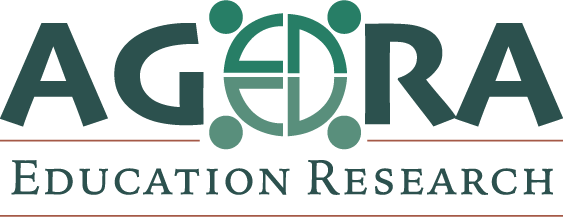
Measurement: test and Survey Development

At Agora Education Research, we provide expert measurement services for assessment and survey development, supporting research projects and data collection studies in national, state, and local education research and policy. Our team specializes in designing reliable and valid instruments that capture meaningful data, ensuring precision in measuring student outcomes, educator effectiveness, and policy impacts. From test development to survey design and validation, we help educational institutions, policymakers, and researchers generate high-quality data that informs critical decisions and drives educational improvements.
How We Measure What Matters in Education
- Track Student Success
We measure academic achievement and growth across key subjects nationwide. - Map Enrollment Trends
We capture who’s learning, where they’re learning, and how education patterns are shifting. - Profile Schools and Colleges
We document the structures, staffing, and resources that shape learning environments. - Follow Educational Journeys
We measure graduation, college enrollment, and career pathways to understand outcomes over time. - Spot Equity Gaps
We highlight disparities in opportunity, access, and achievement to drive more inclusive education systems. - Trace Every Dollar
We track how education funding is spent and how resources impact learning outcomes. - Measure Learning Environments
We assess the school climate, engagement, and supports that contribute to student success.
Service Providers

Aida Ali Akreyi, Ph.D.
Associate
- aaliakreyi@edevaluator.org
- Chantilly, VA
- Survey & Program areas:IPEDS, National Studies
- Service:Data Analysis, Reporting, Test and Survey
- Employment type:Contract, Full time
- Work site:Hybrid, Local to me, Remote
Aida Ali Akreyi, Ph.D.
Associate
Aida Ali Akreyi is a research and data strategy expert with over a decade of experience in federal data collection, institutional research, and education policy. Most recently, she served as Statistician and IPEDS Operations Lead at the U.S. Department of Education’s National Center for Education Statistics, where she directed national postsecondary data collection, compliance, and reporting initiatives, ensuring data integrity, accessibility, and usability. Aida brings deep expertise in leading large-scale research projects, developing performance metrics, and translating complex data into actionable insights for policymakers, institutional leaders, and the public. She holds a Ph.D. in Higher Education Administration and Policy from the University of California, Riverside, and is passionate about using data to inform systems change and expand opportunity.

Samantha Burg, Ph.D.
Associate
- sburg@edevaluator.org
- Arlington, VA
- Survey & Program areas:ICILS, International Studies, NAEP, PIRLS, PISA, TIMSS
- Service:Data Analysis, Project Leadership, Reporting, State and District, Test and Survey
- Employment type:Full time, Part time
- Work site:Hybrid, Local to me, Remote
Samantha Burg, Ph.D.
Associate
Experienced leader in large-scale assessment and psychometrics with over 25 years specializing in educational measurement, statistical analysis, and data-driven reporting. Recognized for managing complex national and international assessment programs and coordinating cross-functional teams through all phases of test development, validation, administration, and analysis. Adept at translating sophisticated data into actionable insights and effectively communicating results to all.

Jodi Jacobson Chernoff, Ph.D.
Associate
- jjchernoff@edevaluator.org
- Potomac, MD
- Survey & Program areas:Early Childhood, Elementary School, International Studies, National Studies, State-level Studies
- Service:Project Leadership, Reporting, State and District, Test and Survey
- Employment type:Contract, Full time, Part time
- Work site:Hybrid, Remote
Jodi Jacobson Chernoff, Ph.D.
Associate
I’m an Education Researcher fueled by a passion for improving the lives of young children and their families through thoughtful, data-driven change. I believe that when research is done well—and shared wisely—it can elevate entire systems of early childhood education and care. My work centers on uncovering what works, for whom, and why, using rigorous program evaluation and applied research to guide practice and policy.
Across federal, state, and local departments of education, foundations, and nonprofit organizations, I’ve collaborated with diverse teams to design evaluations, develop assessments, and build evidence that informs strategy. Whether managing a national study, advising on state policy, or crafting insights for practitioners, I strive to make complex information useful and actionable for those shaping the field.
My approach blends strategic thinking with creativity, problem-solving, and a deep commitment to equity. I led project and staff management for the Early Childhood Longitudinal Study (ECLS), ensuring high-quality results and timely deliverables. I’ve provided technical assistance to Chicago Public Schools, supported content alignment for Oklahoma’s Early Learning Inventory, and helped refine training and assessment protocols across multiple states. My work with the Birth through Eight Strategy for Tulsa enhanced data quality through improved protocols.
Globally, I’ve represented U.S. perspectives in shaping the International Early Learning Study (IELS), overseeing a national pilot and facilitating key conversations with NAEYC and the U.S. Department of Health and Human Services. Throughout, I’ve remained focused on making data meaningful—refining instruments, translating findings for broad audiences, and building bridges between research and practice.
At the heart of my work is a belief: that data, when centered on real people and real needs, can be a powerful tool for advancing opportunity and equity. I’m here to help organizations take the next best step for the children and families they serve.

Kathleen Flanagan, Ph.D.
Board of Directors
- Survey & Program areas:State-level Studies
- Service:Data Analysis, Project Leadership, State and District, Test and Survey
- Employment type:Contract
- Work site:Remote
Kathleen Flanagan, Ph.D.
Board of Directors
Kathleen Flanagan has led numerous evaluation and large-scale assessment projects. Innovative course modules that show educators how to take charge of classroom and school outcomes are available at chartingyourowncourse.com.

Carolyn Grim, Ph.D.
Founder, Board of Directors
- cgrim@edevaluator.org
- Boston, MA
- Survey & Program areas:Middle Grades, National Studies
- Service:Data Analysis, Project Leadership, Reporting, Test and Survey
- Employment type:Contract, Full time, Part time
- Work site:Hybrid, Local to me, Remote
Carolyn Grim, Ph.D.
Founder, Board of Directors


Dr. Grim is an education statistics and psychometrics expert with extensive experience in test development, survey methodology, and quantitative analysis. Her strategic insights and advanced statistical modeling using SPSS, R, and specialized psychometric software result in valid and reliable instruments for scales that yield precise, data-driven decisions. She specializes in enhancing data collection processes and improving survey design while maintaining a commitment to excellence and innovation in educational research.
Lee Honeycutt
Associate
- lhoneycutt@edevaluator.org
- Raleigh, NC
- Survey & Program areas:Elementary School, High School, ICILS, International Studies, Middle Grades, National Studies, TIMSS
- Service:Project Leadership, Reporting, Test and Survey
- Employment type:Contract, Full time, Part time
- Work site:Hybrid, Local to me, Remote
Lee Honeycutt
Associate
Bridge builder, coordinating multiple partner teams on driving scalable, evidence-based solutions. Manage complex projects, supervising teams and aligning protocols with regulatory and compliance standards. Translate data into actionable insights, and foster collaboration across mission-driven organizations and clients. Adaptable, detail-oriented, and proactive, with strong track record in relationship-building, seeking feedback, and analytical thinking. Passionate about data quality, staff development, creating innovative tools, delivering measurable outcomes, strengthening programs and informing policy.

Lisa Kessler, M.Ed.
Associate
- lkessler@edevaluator.org
- Orlando, FL
- Survey & Program areas:High School, ICILS, International Studies, Middle Grades, National Studies, State-level Studies, TIMSS
- Service:Project Leadership, Reporting, State and District, Test and Survey
- Employment type:Contract, Full time, Part time
- Work site:Hybrid, Local to me, Remote, Willing to relocate
Lisa Kessler, M.Ed.
Associate
Lisa Kessler is an experienced Education Research Analyst with a strong track record in school recruitment for large-scale national studies. She excels at building relationships with states, districts and schools, navigating complex approval processes, and meeting ambitious participation goals. With a Master of Education and a data-driven mindset, she translates recruitment outcomes into actionable insights to inform project strategies. Lisa is passionate about using research to elevate student outcomes and ensure diverse voices are represented in education studies.

Anindita Sen, Ph.D.
Associate
- New York, NY
- Survey & Program areas:International Studies, PISA
- Service:Data Analysis, Reporting, Test and Survey
- Employment type:Contract, Full time, Part time
- Work site:Hybrid, Local to me, Remote
Anindita Sen, Ph.D.
Associate
I’m a Researcher with over two decades of experience designing, implementing, and analyzing large-scale education assessments. My work focuses on uncovering meaningful patterns in student learning—across countries, cultures, and contexts—through rigorous data collection and thoughtful analysis.
At the American Institutes for Research (AIR), I collaborated with federal agencies and partner organizations on the U.S. implementation of PISA, a global assessment of student literacy conducted in over 80 countries. This experience deepened my understanding of how school systems and cultural factors shape educational outcomes, and strengthened my ability to translate complex data into practical, evidence-based takeaways. I’ve led technical reviews, managed sensitive student data, and supported the development of high-quality publications under tight deadlines. Beyond analysis, I’ve guided dissemination efforts through in-depth statistical reports, tailored presentations, media briefings, and practitioner-friendly briefs. I also spearheaded the RISE webinar series, which highlights global education research and encouraged dialogue across policy, practice, and research communities.
I’ve always loved the mix of precision, analysis, and people in my work—whether I’m refining survey tools, exploring complex datasets, or mentoring junior staff. I care deeply about making data clear and useful, and I bring empathy and attention to detail to every aspect of the process. Years of remote collaboration have also sharpened my ability to stay organized, meet tight deadlines, and stay connected across teams and time zones.
I’ve seen how much we can learn from different education systems—whether across countries or across states—by comparing student and school-level factors like motivation, instructional methods, and learning environments. Rigorously designed assessments don’t just measure what students know; they help us understand how students learn and grow. I’m committed to using research to shape smarter education policies and create more equitable opportunities for all learners.
